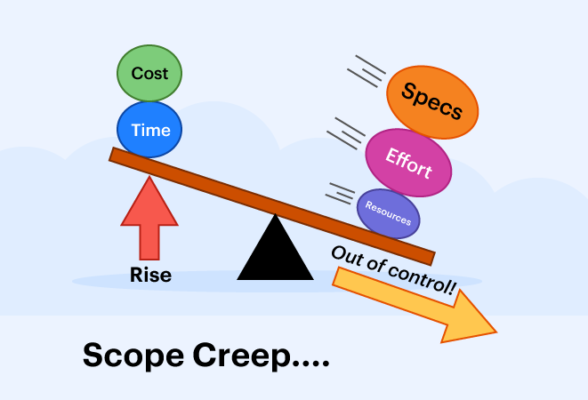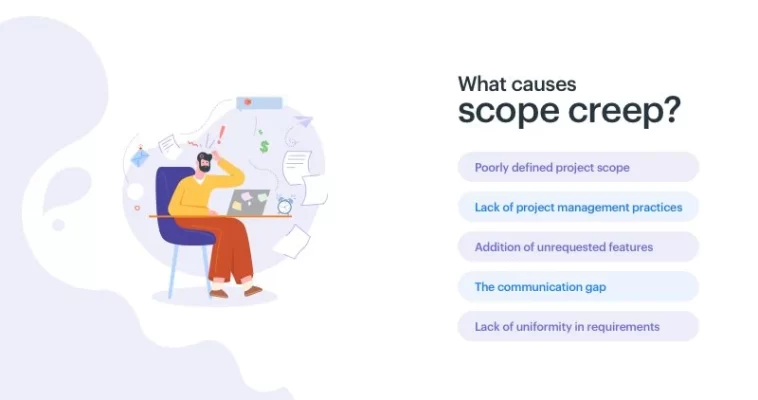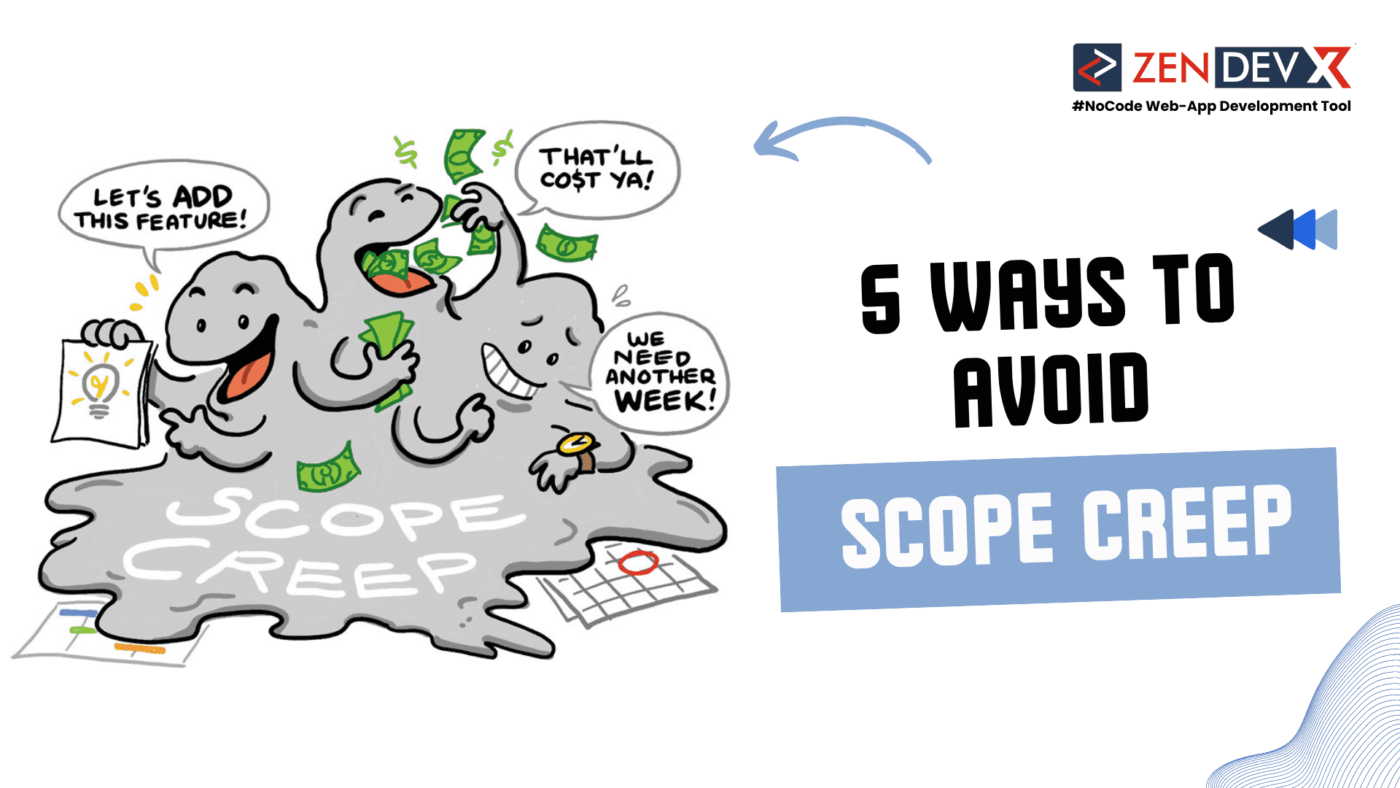Suppose you run a little bakery. One needs to deliver a birthday cake in one day according to schedule. You start getting ready the cake batter after gathering all the components. A few hours later, the same customer calls wanting a strawberry icing on the cake. Since you haven’t yet cooked the cake, you agree.
The client calls you once more and wants a three-tier cake. Another call then instructing you to top with a mickey mouse. And then still another to arrange on the side a “Happy Birthday Matt”. Although you know the delivery time is limited and it will cost a little more than the originally decided upon price, you are grudgingly in agreement.
What then went wrong in this case?
At first, the extent of the project was not precisely known, and the baker accepted minor adjustments without altering the estimated schedule or the budget. Project managers constantly deal with scope creep, which is defined as follows.
Describes Scope Creep ?

A small departure of the project from the intended scope by means of additional features is known as scope creep. It begins with a somewhat modest change request for which you are willing. These demands gradually mount up and finally cause major issues.
Knowing the meaning of scope in a project helps one in project management to grasp the actual meaning of scope creep. “The extent of what a project will produce and the work needed to produce it,” the PMBOK Guide defines as scope.
The Pulse of Profession 2018 from PMI shows that 52% of all projects experience scope creep in one form or another. Another worrying element is that scope creep plagued 43% of projects seven years ago. As seen, the percentage is really “creeping” up rather than declining.
What Does Scope Creep Look Like ?
More often than you would think, scope creep occurs inside project teams:

- Many last-minute architectural alterations in the design plan were blamed for a delay of 54 weeks in opening a public library.
- Denver Airport’s luggage handling system fell short of completion on schedule since important stakeholders were not contacted in time and their comments had to be included into operation.
- When the Chrysler PT Cruiser was introduced, factors of how vehicles will be delivered to dealerships in time were not given any thought. Massive delays and consumers moving to other manufacturers followed from this. Every facet of a project neglected at first presents scope creep potential.
For What Reason Does Scope Creep Occur ?
The extent of a project fluctuates for many different reasons. Little adjustments in the criteria finally lead to additional features. Still another factor could be changes in client firm management. One kind of scope creep is when clients fail to adequately express their vision, which could cause the project manager to overlook the correct project scope.
If project managers better handle their tasks, most of the reasons for this departure can be avoided. The PMI’s Pulse of Profession 2018 shows clearly the outcomes of implementing improved project management techniques. Projects run free from scope creep when organizations with high degrees of maturity and stronger processes avoid it.
It is remarkable that 33% of projects in companies with more competent project managers were affected.
The Most Often Occurring Reasons of Scope Creep in Projects Are:
Inappropriate Project Scope
Usually the main obstacle in scope creep risk reduction is ineffective project management communication between the project manager and the clients. A project manager who does not completely grasp the requirements will provide a final result quite different from the client’s vision.
Sometimes customers are also to blame, particularly for inventive initiatives. More uncertainty results from their often vague view of what they want. For project cooperation between teams, statements like “I’ll know when I see it” create challenges.
Insufficient Project Management Techniques
One tried-and-true approach to stop scope creep from destroying your whole project is to firmly adopt and follow project management techniques.
Imagine the client asks for a basic tweak during a kickoff conference and you know it would only take one hour to complete. You will thus naturally not consider documenting that modification, but over time these things build up and can create project delays.
The absence of a centralized project management system is another element possibly generating issues. You will miss something at last when everything is done randomly.
Additional Unrequested Elements
Sometimes project teams start to concentrate on introducing extra features to wow the clients. Should the project have to be finished in a very short time, this could backfire.
Spending time on additional features means you either performed below par on a necessary feature or you won’t have time to complete it, which will finally cause undesired delays.
The Gap in Communication Among Project Participants
The communication gap among the project stakeholders is yet another major factor for illegal changes in the aims of a project. Emails and phone calls from the project team may go unacknowledged by clients swiftly. Likewise, occasionally the project finds itself in a bottleneck and requires widening the scope.
Nevertheless, the project teams make the decision entirely without customer participation. Unapproved adjustments resulting from this might not be preferred by the client.
Lack of Consistency in the Needs of the Client
“Too many chefs spoil the broth,” and this is certainly the case with ongoing initiatives. Should the clients choose several individuals to handle project aspects, their differing vision may eventually lead to significant uncertainty. Giving several project team members significant decision authority might likewise cause problems in a similar vein. Although the project benefits from allowing the team members some degree of autonomy, as a manager your responsibility is to define the boundaries.
Although these problems are somewhat difficult to prevent, there are several actions you can take to guarantee that you are in charge and the consequences of scope creep stay at least minimal.
Why Is Project Scope Creep Detrimental ?
Usually devastating for a project, project scope creep is rare; yet, there are times when deviating from the initial plan is justified. Many projects last several years, hence changes in the market dynamics or in the needs of the consumers might affect the extent of the project.
Few problems resulting from scope creep are:
- Insufficient communication
- Insufficient knowledge of project scope
- Ineffective target formulation
Is Scope Creep Something One Should Welcome?
You should understand that scope creep cannot be totally avoided from your initiatives. Demand from customers could shift midway through the project. You should so constantly be ready for some adjustments that would be favorable.
Some benefits of scope creep in a company are listed here:
Increases Client Retention
Meeting modification requests indicates that your staff is exceeding expectations for a customer. This not only attracts fresh clients but also guarantees that past ones come back to you for further initiatives, so strengthening your profile in the market.
Guarantees Market Acceptability
Your ultimate product will be easily able to satisfy market needs when your features are routinely changing. However, adjustments have to be in line with the specified project limitations and show themselves in the revised budget and timeline.
Boosts Income
If your organization bills customers per hour or if your rates follow the deliverables required. Change requests could indicate a boost in your company’s income.
Enhances the Procedures of the Team
The change in the goal of the project could also present your team with a learning possibility. You can maximize your internal procedures going forward to help to lower scope creep.
Why Aggressively Fight Scope Creep ?
Dealing with scope creep aggressively is absolutely vital since:
- It can result in major cost overruns, a breakdown in team communication, ineffective team time management, rapid team fatigue, and a lack of clarity over final deliverables.
Clearly, scope creep can have a negative impact on project team welfare as well as output. This emphasizes the need for addressing the reasons for scope creep long before a project is started.
Scope Creep vs. Scope Change vs. Scope Gap
One unofficial, slow change in scope is scope creep. Not suitably revised due dates and budgets could cause discontent or even project failure.
When both the customer and the project manager formally decide to add a project feature or increase a functionality—for example, scope change—that is when both of them are acting. It is under control and entails changes to resources, budgets, and deadlines.
When the project team’s perspective on the scope and the client’s expectations do not match, scope gap results. In non-agile projects, this is a typical issue since the scope is sometimes regarded as set. Agile projects expect the scope to evolve and since the development is iterative, scope gaps cannot exist outside of one iteration.
5 Ways to Prevent and Control Scope Creep ?
Although you cannot totally eliminate scope creep and occasionally the success of the project depends on a minor departure from the initial plan. In a project where the objective of the project manager should be to control scope creep in such a way that guarantees the success of the project and leaves the clients happy with your service, you can manage scope creep in such manner.
I promise the clients won’t return if you keep turning down every single request they make. In project management, the five guidelines below help to prevent and minimize scope creep:
1. Act Early
You have to be alert starting on the first day if you are to keep ahead. Make sure everything is clear by involving all the stakeholders throughout the project schedule.
To further grasp the vision of the clients, it is also advisable to ask them to create a project charter and a list of features in sequence.
2. Sort Your Chores According to Importance
Developing a list of essential chores that have to be finished will help one to accomplish the project. Many contemporary project management systems even depend on a priority list since it is so crucial.
Setting priorities helps you to keep your team under control and stop them from squandering time by concentrating on pointless chores.
3. Charge It a Price
Charging for extra features is another approach to limit the demand for changes. This will not only boost your income but also discourage unwarranted change requests.
In a same vein, a zero-sum game can also be a wise choice. Make sure you document anything should a feature be included in the project charter. This will maintain the time and money you will need to devote to a given project consistent.
4. Ask Technology to Assist You
Modern undertakings cannot be finished satisfactorily without technological support. Moreover, I mean not spreadsheets since they will complicate your work. Your team’s performance can be much improved with several project management instruments.
5. Know When to Decline
When circumstances call for it, a project manager should be able to stand up to stakeholders and turn down change requests. You have to explain to them how particular adjustments might affect the whole project.
If too many adjustments are desired, ask for a deadline extension. Early on, good client communication will help you avoid many issues later on.


